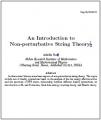
An Introduction to Non-perturbative String Theory
by Ashoke Sen
Publisher: arXiv 1998
Number of pages: 130
Description:
In this review I discuss some basic aspects of non-perturbative string theory. The topics include test of duality symmetries based on the analysis of the low energy effective action and the spectrum of BPS states, relationship between different duality symmetries, an introduction to M- and F-theories, black hole entropy in string theory, and Matrix theory.
Download or read it online for free here:
Download link
(920KB, PDF)
Similar books
 String Theory and the Path to Unification
String Theory and the Path to Unificationby Keith R. Dienes - arXiv
This is a pedagogical review article surveying the various approaches towards understanding gauge coupling unification within string theory. The author provides an overview of the different approaches that have been taken in recent years.
(12479 views)
 Topological Strings and their Physical Applications
Topological Strings and their Physical Applicationsby Andrew Neitzke, Cumrun Vafa - arXiv
We give an introductory review of topological strings and their application to various aspects of superstrings and supersymmetric gauge theories. This review includes developing the necessary mathematical background for topological strings.
(9187 views)
 Kac-Moody Algebras in M-theory
Kac-Moody Algebras in M-theoryby Sophie de Buyl - arXiv.org
Contents: A First Approach; General Framework; Homogeneous Cosmologies; Oxidation; Hyperbolic Algebras; General Framework; Dirac Fermions; Eleven Dimensional Supergravity; Dualities and Signatures of G++ Invariant Theories; etc.
(9513 views)
 String Theory
String Theoryby Maximilian Kreuzer - Technische Universitat Wien
Contents: Introduction; The bosonic string; Quantization of bosonic strings; Superstrings; Conformal field theory (conformal group, Wick rotation and Euclidean fields, Tensors, energy-momentum, and correlations, First order systems and ghosts, etc).
(10897 views)